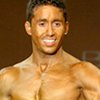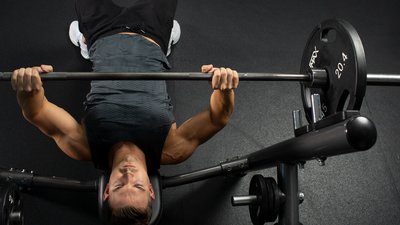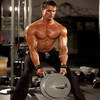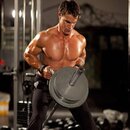This was the description Ken Waller gave Arnold Schwarzenegger in the film Pumping Iron when Arnold was posing and hit a double back bicep pose.
Every time I see that clip, it motivates me and inspires me. The acceptance and total understanding they portrayed about what they were doing was motivating and impelling, especially in a time when resistance training, especially bodybuilding, was not mainstream and was more of a subculture or taboo. Getting the upper back fully developed is a matter of understanding why you are training back and being motivated to do it.
"Looks like a roadmap back there, with fingers all over it."
In this discussion, the back will be classified into 2 categories, V-Taper training and Detail/Definition training. V-Taper training refers primarily to hitting the lats with the intended purpose of adding width and thickness. Conversely, Detail/Definition training refers sculpting the back to be able to visibly see the shoulder pockets (scapular musculature), the x-mas tree, and the lesser talked about bat shape seen when the back is completely ripped.
Back training is very important for the following reasons:
- It adds to side-view thickness (Hansen, 2005).
- It enhances the all-important V-taper.
- It creates muscle balance with chest musculature (Barlow et al., 2002).
- It gives one more options with poses and body positions to use in a posing routine.
- It prevents shoulder impingement issues by playing an integral role in preventing forward shoulder (Gross et al., 1993).
The keys to developing an awesome back are shrugs, rows, and pull-ups. Good trap development comes from heavy barbell shrugs and the indirect effect of overhead shoulder presses and upright rows. However, to directly stimulate the traps for mass and to get the "shoulder pad" look on a most muscular, one needs to shrug heavy at times and at other times, shrug for the "feel."
I like to do traps on shoulder day. For my back day, I train my mid-back mainly and the two key priorities in my back days are lat width and upper-mid back definition.
However, the emphasis of this article will be on developing back width, thickness, and muscularity. Weighted pull-ups are the most effective lat exercise one can do. Why? Unlike lat pulldowns, a free-body hanging from a bar seems to have a significant effect on the lats.
Most exercises that are either closed-kinetic or involve the hands or feet being fixated against a non-moving bar or platform of which the body has to move around it are the most effective mass-builders (Rivera, 1994).
Such exercises as squats, deadlifts, dips, and pull-ups are all examples of closed-kinetic exercises or exercises of which the body is stabilized against an immovable surface which allows maximal force output (Behm, 2002; Lansky, 1999; Steindler, 1973).
The logic to pull-ups being the most effective exercise for lats is founded on basic physics. During a seated lat pulldown, the top of the thighs take up some of the force when stabilizing against the leg pad, thus the lats are not being fully isolated. On the contrary, in a weighted pull-up, the only point of contact is the hands grabbing the bar, thus the lats have to do all the work in moving the weight.
The All-Important V-Taper
The V-taper is an aspect that has seemed to have lost a lot of attention and respect. The one thing that dictates a natural good-looking v-taper is having a small waist AND having very strong lats.
Waist Control
The first aspect of having a small waist is partly genetic, but a lot of it is simply a matter of knowing how to come in absolutely ripped for a show. This means having a body fat that is <7% body fat and proper endurance training of the core to keep the abs tight or maintain a vacuum.
For instance my waist is typically around 31-32 inches relaxed, but on-stage, it is around 27-28 inches, because I keep my abs sucked-in or tight throughout the entire time. The v-taper is more prominent in natural bodybuilders or the 1970's bodybuilders in the "Golden Age of Bodybuilding."
I am under the assumption that the reason why the waists remained small back then was likely because although steroids were used, they were likely not as abused as they are today. Furthermore, with the advent of all these new products that are supposedly safe, yet are not FDA approved, we just have no way of telling what people are putting into their bodies.
The most incredible site to my eyes is when I see a natural bodybuilder or pharmaceutically-enhanced bodybuilder with a small waist and wide lats. The key to this look is "proportion!!!"
Once the waist gets beyond a certain point of width, the lats can never get big enough to make-up for this disproportion. And this is my dismay and resentment with massively out-of-proportion physiques being more popular in bodybuilding today.
The bloated and distended abdomens do not appeal and this is not a truly proportionate V-taper. Thus, the most important component to a V-taper is the waist!!! So my advice to those of you wanting the V-taper that resembles those of "The Golden Age of Bodybuilding," staying natural is the way to go!
Your waist will remain "natural-looking" and your internal organs will not "un-naturally" grow from aid of certain pharmaceuticals. If you don't want to take my word for it, just listen to the radio pod cast interview with Dr. Franco Colombu.
In this interview, Dr. Columbu mentions the fact that physiques are not as aesthetic and proportionate as they were back then. Well maybe this is because Dr. Columbu has not made any stops at some natural bodybuilding contests. These proportionate and aesthetic physiques are still out there!
Lat Strength
This aspect of having wide and gaping lats based on the notion "Stronger muscle is bigger muscle." Or to be more scientific about it, "Form Follows Function" (Russell et al., 2000). Either way, to have big lats, one must be able to do some heavy-weighted pull-ups. Now I know everyone is different, but for a large majority of you out there, getting stronger on weighted pull-ups is a sure-fire way of guaranteeing you will get some thicker and wider lats.
Best Lat-Width Exercise Weighted Pull Ups
Goal Here Is To Stretch The Lats Wider For A Better V-taper.
The grip used is important. I like to switch grips for various reasons.
- Shock principle
- Emphasizing different segments of lats (i.e. Outer lat, lower lat, etc.)
- Use the grip that isolates the outer lats most. Research has shown that a wider than shoulder width grip will target the lats more effectively than neutral or supine (Lehman et al., 2004; Signorile et al., 2002). Usually this will be right at the bend of a pull-up bar.
Regimen 1: 3x2.
Regimen 2: 2-3x2-3 105-130% of 1-RM negatives. Do these very infrequently, as they are higher risk due to extreme intensity and could result in overtraining or worse, injury if used too frequently.
Regimen 3: Now most of you know about how to do weighted-pull-ups. Use either a weighted dip-belt OR hold a dumbbell between your feet. Well as a result of snapping to pull-up belts in the middle of sets, I had to figure out another way to train my lats heavy to keep them big while I searched for a strong and durable pull-up belt.
So, I began clamping a dumbbell between my feet for weighted-pull-ups. From personal experience, I can tell you that there is some physiological response difference with doing pull-ups with the resistance being in a different location.
I would recommend adding this variety to your weighted pull-ups, as it will certainly shock your lats and give you new-found growth!! Switch up weighted pull-ups from the waist to the feet from time to time.
Just so you know a lot of pull-up belts have integrity for only two-to-three 45lb plates. This coming from my personal experience of having two belts snap apart in the middle of a set!!! My stats on this exercise are as follows:
When I first started out, I could barely do 3-4 reps with one 25 lb. plate. Now, just 2 years later, I can do 3-4 reps with two 45 lb. plates!! I have also done negative-only reps with as many as four 45 lb. plates.
When using a dumbbell, I have been able to clamp a 95 lb dumbbell between my ankles and I bend my knees back to 90 degrees. And not coincidentally, but rather by way of "Form Following Function," my lats have also gotten bigger and wider!!!!
Best Lat-Thickness Exercise T-Bar Row
Goal Here Is To Add Density And Thickness To The Lats.
Arnold Schwarzenegger's favorite back exercise. I can't get enough of this exercise. Every time I find myself wanting to stop short on a set, I think of Pumping Iron when Arnold was doing the T-Bar rows with something like six-eight 45's on the bar!!
Just the sound of the plates clanging as he pulled them into his chest rep after rep is so motivating. This exercise cannot only be used for thickness, but also getting your back ripped. Just depends on the rep range and load used.
Regimen 1 (Lat Thickness): 3x6-8 or 3x20 with weight you can normally do 15 reps with and just about fail. I suggest alternating these rep schemes or even doing a pyramid of 4x12-10-6-20.
Regimen 2 (Ripped Back): 4-5x 20-30 focusing on the negative and peak contracting the shoulder blades together at the top of the range of motion. Pull through the burn; it will completely be worth it in the long-run.
Getting The Back Absolutely Shredded With Detail/Definition Training
The key to getting the back ripped in my personal experience is by increasing the total work done and hitting it from every angle possible. This involves doing more sets and reps and changing grips, body position, and arm position. Stick to rep ranges of 6-10 reps for the first of 1 or 2 exercises for back, then gradually begin increasing the reps to 10-15, to 15-20, and then finish with 1 or 2 exercises of 50 or more reps!!! The workout should look something like this:

BodyFit
$6.99/month- 2,500+ expert-created single workouts
- 3,500+ how-to exercise videos
- Detailed workout instruction
- Step-by-step workout tips
- Training at gym or at home
- Access to Workout Plans
- Access to Bodyfit App
- Store Discounts
Already have a Bodybuilding.com account with BodyFit? Sign In

What comes with BodyFit?

- Instructional Videos
Don't risk doing a workout improperly! Avoid injury and keep your form in check with in-depth instructional videos.

- How-to Images
View our enormous library of workout photos and see exactly how each exercise should be done before you give it a shot.

- Step-by-Step Instructions
Quickly read through our step-by-step directions to ensure you're doing each workout correctly the first time, every time.
Conclusion
There are no secrets to building your own roadmap, with fingers all over it. Like anything worth achieving, it will take diligent determination, drive, and passion. But eventually, you can have that great feeling when you turn to the judges and audience at a show, and have that feeling of knowing the cheers will be for you when you take everyone watching on a journey to an incredible place that can only be found by viewing your "Roadmap."
References
- Barlow et al. (2002). Shoulder Strength and Range-Of-Motion Characteristics in Bodybuilders, The Journal of Strength and Conditioning Research, 16(3), 367-372.
- Delavier, F. (2006). Strength Training Anatomy, Human Kinetics, Champaign, IL.
- Gross et al. (1993). Anterior Shoulder Instability in Weightlifting, American Journal of Sports Medicine, 21, 599-603.
- Hansen, J. (2005). Natural Bodybuilding. Human Kinetics, Champaign, IL.
- Lansky, R. (1999). Point/Counterpoint: Open-Versus-Closed-Kinetic Chain Exercise, The Journal of Strength and Conditioning Research, 21(4), 39.
- Lehman et al. (2004). Variations in Muscle Activation Levels During Traditional Latissimus Dorsi Weight Training Exercises: An Experimental Study, Dynamic Medicine, 3(1), 4-10.
- Rivera, J. (1994). Open vs. Closed Kinetic Chain Rehabilitation of the Lower Extremity, Journal of Sport Rehabilitation, 3(2), 154.
- Russell et al. (2000). Form Follows Function: How Muscle Shape is Regulated By Work, Journal of Applied Physiology, 88, 1127-1132.
- Signorile et al. (2002). A Comparative Electromyographical Investigation of Muscle Utilization Patterns Using Various Hand Positions During the Lat Pull-down, The Journal of Strength and Conditioning Research, 16(4), 539-546.
- Steindler, A. (1973). Kinesiolgy of the Human Body Under Normal and Pathological Conditions. Charles C. Thomas, Springfield, IL.




